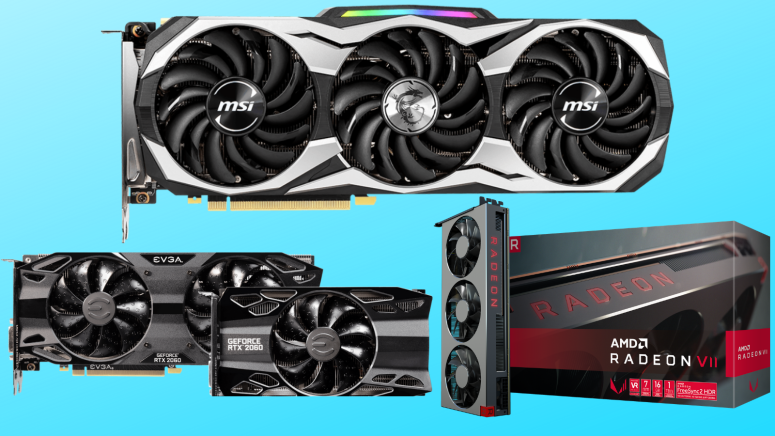
The Best Graphics Cards to Buy in 2019 For Gamers of All Budgets and Requirements
So you have bought a gaming CPU and a matching motherboard to build the gaming rig of your dreams, but the job is only half complete. For good gaming performance, you need a dedicated graphics card or GPU that can really push those frames to your monitor in high quality.
While there are only two major players in this segment — NVIDIA and AMD — it becomes an ordeal to actually select the best graphics card for your gaming and entertainment needs. Both NVIDIA and AMD offer GPUs that cater to all pricing tiers. You can get the latest GPUs on offer or go for an older generation model to save some money. Whatever you choose, you should keep in mind a few pointers before splurging in your hard-earned cash.
It is important that you decide whether you want to play the latest games at FHD, 2K, or 4K resolutions. This not only impacts your budget for the graphics card, but it also directly influences the budget for other components such as the CPU, motherboard, RAM, and PSU. While 2K and 4K are demanding, you really don't need a top of the line graphics card to game at FHD. The amount VRAM also makes a significant difference in performance as more games are becoming increasingly texture heavy.
With that information, here are our picks for the 8 best graphics cards to buy in 2019 across all requirements and budgets.
1. NVIDIA GeForce RTX 2080 Ti Founders Edition
- GPU Core / CUDA Cores: TU102 / 4352
- Base / Boost Core Clock (MHz): 1350 / 1635
- VRAM (GB): 11 GB GDDR6
- TDP (W): 260
- Connectors: 3x DisplayPort; 1x HDMI; 1x USB Type-C
- Dimensions (W x D x H): 10.5 x 1.75 x 4.55 in
For gamers who prefer playing at 4K at all settings maxed out in the latest games, the NVIDIA RTX 2080 Ti is the GPU to have. The RTX 2080 Ti is available from most major suppliers, and the NVIDIA Founders Edition uses a reference design that shows the best of what the new Turing GPU has to offer. The new Turing family is all about ray tracing, and the 2080 Ti is the best card for it. The TU102 GPU core boasts of 4352 CUDA cores, 544 Tensor cores, 68 ray tracing cores, 544 texture units, and 34 PolyMorph engines. Even with two units disabled, that's an astounding number of processing units for a GPU. The RTX 2080 Ti supports 11 GB of GDDR6 VRAM that offers a 14 Gbps memory bandwidth on a 352-bit interface.
Performance-wise, the RTX 2080 Ti offers better scores than a Pascal-based Titan V. That is saying a lot and you'll still be left with enough juice while running today's games. However, not many games support ray tracing as of yet, and while ray tracing offers a considerable bump in visual quality, it comes with a very impact on frame rates. Several titles will be offering support for another Turing technology called Deep Learning Super Sampling (DLSS). DLSS can improve image quality by automatically filling in the required pixels with just half the number of input pixels. This can potentially improve performance in games that support this feature and is achieved via the Tensor cores. Therefore, for those who need great playability for current and future games without any compromises, the NVIDIA RTX 2080 Ti is the best graphics card money can buy.
- Pros: Excellent performance in 4K; Good thermals; Ray tracing and DLSS
- Cons: Expensive; Not many games can make use of all features
2. MSI Gaming GeForce GTX 1660 Ti
- GPU Core / CUDA Cores: TU116 / 1536
- Base / Boost Core Clock (MHz): 1500 / 1750
- VRAM (GB): 6 GB GDDR6
- TDP (W): 120
- Connectors: 3x DisplayPort; 1x HDMI
- Dimensions (W x D x H):10.91 x 1.54 x 5.51 in
If all the ray tracing and fancy AI tech of the RT-series cards don't amuse you, the GeForce GTX 1660 Ti is probably the graphics card you are looking for. The GTX 1660 Ti is still based on the Turing architecture so you get all the new innovations such as adaptive shading, more CUDA cores, unified cache, and even GDDR6 memory. The TU116 GPU cores offer 1536 CUDA cores and 96 texture units with a reference base clock of 1500 MHz and a boost clock up to 1770 MHz. Of course, the speeds can vary depending on OEM and their cooling solutions. Overall, the TU116 core can offer 5.4 TFLOPS of FP32, and 10.9 TFLOPS of FP16 compute performance. The GTX 1660 Ti makes a perfect upgrade to the GTX 1060 of the previous generation and offers increased memory bandwidth thanks to 6 GB of 12 Gbps GDDR6 modules.
Due to the increased processing power and higher memory bandwidth, the GTX 1660 Ti is easily one of the best graphics cards for 2K gaming. While the GTX 1660 Ti actually comes close to GTX 1070 levels and also offers tough competition to AMD's Radeon RX 590, the card is still expensive while AMD has been steadily reducing prices of its Polaris cards. The only major competitor to the GTX 1660 Ti is the RTX 2060 and which card would make a better investment depends solely on your thoughts about utilizing ray tracing and DLSS in supported games.
- Pros: Excellent performance for FHD and 2K gaming; Lower power consumption compared to AMD cards
- Cons: No RT/tensor cores
3. NVIDIA GeForce RTX 2070 Founders Edition
- GPU Core / CUDA Cores: TU106 / 2304
- Core Clock (MHz): 1410 / 1710
- VRAM (GB): 8 GB GDDR6
- TDP (W): 175
- Connectors: 2x DisplayPort; 1x HDMI; 1x DVI-D; 1x USB Type-C
- Dimensions (W x D x H): 9 x 1.75 x 4.4 in
Gamers who don't need all the raw power of the RTX 2080 / RTX 2080 Ti but still require enough power for gaming at resolutions 2K and above along with excellent performance for VR headsets should look at the NVIDIA GeForce RTX 2070 Founders Edition. The RTX 2070 is based on the TU106 GPU core and offers 2304 CUDA cores with a base clock of 1410 MHz and can boost up to 1710 MHz. The TU106 can offer perceivable improvements in performance over the older GTX 1080 across all resolutions. The TU106 in the RTX 2070 offers 288 Tensor cores, 36 ray tracing cores, and 144 texture units. The RTX 2070 supports 8 GB of GDDR6 VRAM on a 256-bit memory bus for a bandwidth of 14 Gbps. While the RTX 2070 offers a subset of most features found in the more expensive RTX 2080 and RTX 2080 Ti, it does not support NVIDIA's NVLink technology that lets you combine two similar GPUs together for double the processing power and memory bandwidth.
In terms of performance, the NVIDIA GeForce RTX 2070 poses stiff competition to the last gen GTX 1080 and the AMD Radeon Vega 64 in the sub-$500 brackets. However, actual cards from various vendors will have increased pricing due to additional vendor-specific customization and cooling solutions. While ray tracing and DLSS are good features to boast of, there aren't too many games that can take advantage of it at the moment. Given the excellent performance at 2K and acceptable performance at 4K, we'd still suggest watching the prices before splurging in on this as there isn't too much of an advantage of the last generation's GTX 1080.
- Pros: Better performance than GTX 1080 and Vega 64; Good thermals
- Cons: Can get expensive depending on the vendor
4. Sapphire Radeon Nitro+ RX 580
- GPU Core / CU: Polaris 10 / 2304
- Base / Boost Core Clock (MHz): 1340 / 1411
- VRAM (GB): 8 GB GDDR5
- TDP (W): 185
- Connectors: 2x DisplayPort; 2x HDMI; 1x DVI-D
- Dimensions (W x D x H): 12.75 x 2.75 x 8.5 in
The new NVIDIA RTX cards may seem droolworthy and rightly so given their new features, but they are still an expensive proposition for the majority who play games at 1080p. This is when you take a look at options from Team Red. The AMD Radeon RX 580 is not a new card per se. It is a rehashed version of the older RX 480 only with better thermals and slightly improved performance. AMD cards excel in the mid-range and upper mid-range segments, and they also have been famous for those into cryptocurrency mining. Our focus here is restricted to gaming, though and the RX 580 performs very well in most AAA titles. Sapphire has traditionally been one of the trusted brands when it comes to AMD GPUs, and the Radeon Nitro+ RX 580 is no different. Sapphire offers two BIOSes on the Nitro+ that offer gaming and silent modes depending on your requirement. The Nitro+ looks simple and does not sport any fancy RGB lights. Although the RX 580 is known for higher temperatures, the provided cooling solution works well to keep everything under control.
The main competition for the RX 580 comes from the NVIDIA GeForce GTX 1060 6 GB. However, AMD has shown to have an edge in most DX12 titles so you can actually game at 2K high settings without turning on anti-aliasing. The high onboard RAM also helps to provide enough room for heavy textures. AMD includes the WattMan software to easily undervolt the card if needed. The only major downside is the power draw, which requires AMD's board partners to bundle robust cooling solutions. Sapphire offers good enough cooling that can handle the card well under load so this shouldn't really be an issue with this card.
- Pros: Great mid-range option for FHD and 2K gaming; Works best with DX12 titles
- Cons: High power draws
5. Asus ROG Strix GeForce RTX 2060 OC Edition
- GPU Core / CUDA Cores: TU106 / 1920
- Base / Boost Core Clock (MHz): 1395 / 1710
- VRAM (GB): 6 GB GDDR6
- TDP (W): 160
- Connectors: 2x DisplayPort; 2x HDMI
- Dimensions (W x D x H): 16 x 3.5 x 9.2 in
The Asus ROG Strix GeForce RTX 2060 OC Edition is an excellent choice for those looking to game at ultra settings at 1080p 60 fps with some real-time ray tracing chops thrown in. Although the RTX 2060 launched a bit late, it managed to steal a lot of limelight away from the AMD Radeon RX Vega 56 and the RX 590 by retailing for roughly the same price and offering more performance. While specific prices will vary depending on the vendor, there is little doubt that the RTX 2060 is one of the best mid-range cards in the market today. The Asus Strix RTX 2060 OC Edition offers a base clock of 1395 MHz and a boost clock of 1710 MHz with 6 GB GDDR6 VRAM. The card has a TDP of just 160 W and runs relatively cool even under load. The RTX 2060 can support VR headsets, but Asus has not provided a dedicated VirtuaLink USB Type-C port and has made with just two DisplayPort ports and two HDMI outs. This card also has two RGB zones — one above the fins and one in the back — and can be controlled via Asus's Aura Sync software.
The ROG Strix 2060 OC Edition is easily one of the best graphics cards for the money assuming that you can find one at reasonable prices, of course. While the Founders Edition should be priced at expected MSRPs, cards from add-in board partners such as Asus will definitely be on the higher side. Ray tracing is supported, but due to the lower number of RT cores, performance can take a drastic hit. DLSS should be able to help to an extent, but that requires implementation from the game developer's side as well. That being said, if you are looking for a good upgrade from a GPU that is at least a couple of generations old and you mostly game at 1080p, the RTX 2060 is the card to buy.
- Pros: Great for 1080p ultra gaming; Entry-level ray tracing abilities
- Cons: No VirtuaLink USB Type-C port; Expensive than Founders Edition
6. PowerColor Radeon VII
- GPU Core / CU: Vega20 / 3840
- Base / Boost Core Clock (MHz): 1400 / 1750
- VRAM (GB): 16 GB HBM2
- TDP (W): 295
- Connectors: 3x DisplayPort; 1x HDMI
- Dimensions (W x D x H): 11.02 x 1.57 x 4.92 in
While the 2017 AMD Vega 64 may have enough performance to come close to a Pascal GTX 1080, AMD really didn't have any worthwhile competition to NVIDIA's RTX series. All that changes with the Radeon VII. The Radeon VII is based on the Vega20 core that offers 3840 CUs with a base clock of 1400 MHz that can boost up to 1750 MHz under load. The Radeon VII, which is more or less a consumer version of the Instinct MI50 server GPUs, is the world's first 7 nm GPU. The Radeon VII is available directly from AMD or from add-in board partners such as PowerColor, Sapphire, and XFX. Since the Radeon VII is a direct derivative of the enterprise-focused Instinct MI50, it also performs very well in Compute applications and is aided well by the massive 16 GB of HBM2 RAM.
AMD hoped to beat the NVIDIA RTX 2080 with the Radeon VII, but it could come only close than actually beating it. However, the Radeon VII does have good leads in games such as Far Cry 5 and Battlefield 1 that are very memory intensive. Improvements concerning the Vega 64 are noticeable in 2K and 4K despite a reduced number of CUs compared to the latter. The increased VRAM, while good to have, don't find much use in today's AAA games yet. However, it can be of potential use to those into content creation or scientific apps, which require more RAM than even the 11 GB present in the RTX 2080 Ti.
- Pros: Large amount of VRAM; Great for 4K gaming and content creation
- Cons: Does not beat the RTX 2080 convincingly
7. XFX Radeon RX Vega 56
- GPU Core / CU: Vega10 / 3584
- Core Clock (MHz): 1247 / 1546
- VRAM (GB): 8 GB HBM2
- TDP (W): 295
- Connectors: 3x DisplayPort; 1x HDMI
- Dimensions (W x D x H): 11.14 x 1.57 x 5.12 in
The AMD Radeon Vega 56 was AMD's attempt to dethrone the NVIDIA GTX 1070, and in most graphics cards comparisons, it did manage to the give the GTX 1070 a run for its money. Unlike its big brother, the Vega 64, the Vega 56 does not offer any liquid cooled versions. The Vega 10 architecture is a marked departure from Polaris and offers the Infinity Fabric interconnect that is found in Ryzen CPUs to the GPU lineup. The Vega 56 is a powerful GPU and uses the HBM2 memory instead of the standard GDDR found in Polaris and NVIDIA GPUs. Developers are yet to create games that can take full advantage of this type of VRAM and hence, you might not find much of an incentive to lap up Vega 56 if you are already rocking a comparable NVIDIA counterpart. However, in games that use DirectX 12 or Vulkan, the Vega 56 does manage to have a good lead over NVIDIA.
The XFX card is OC capable out of the box, and you can easily squeeze out more performance using the AMD Wattman software. This card also comes with much improved VRMs and better cooling that places it a cut above other Vega 56 vendors. Although AMD aimed to take on the GTX 1070 with this card, performance seems just to fall short. A lot of Vega 56 features such as the HBCC and Rapid Packed Math are yet to be fully utilized by major game developers, and in games that employ those, the Vega 56 wins handsomely. Pricing has been another sore point for the Vega lineup. AMD's move to offer HBM2 memory, which while better than GDDR5 in many aspects, has proven to be expensive and has contributed to delayed launches. Nevertheless, if you play games that cater well to AMD cards at FHD or 2K ultra settings, the XFX Radeon RX Vega 56 will make a solid investment. Just be sure to watch out for the prices.
- Pros: Very good 2K performance; Has support for futuristic technologies; High bandwidth VRAM
- Cons: Expensive; Does not really beat the GTX 1070
8. MSI Radeon RX Vega 64
- GPU Core / CU: Vega10 / 4096
- Core Clock (MHz): 1200 / 1536
- VRAM (GB): 8 GB HBM2
- TDP (W): 295
- Connectors: 3x DisplayPort; 1x HDMI
- Dimensions (W x D x H): 10.6 x 1.6 x 4.3 in
The Vega 64 is AMD's second-biggest card (the first place now goes to the Radeon VII) and was pitched as a direct competitor to the NVIDIA GeForce GTX 1080 when it launched in 2017. Based on a 14 nm process, Vega 64 brought a lot of new features to AMD's Graphics Core Next (GCN) architecture. Although the Vega 64 has a rated TDP of 295 W, it can support two BIOS modes, one of which offers a saver mode that lowers the TDP to 150W. Like the Vega 56, the Vega 64 performs better than the competition in optimized titles such as Dawn of War III, The Division, Doom, etc. However, it loses out to the GTX 1080 when it comes to games such as Ghost Recon or The Witcher 3. Gaming at 2K ultra is a cake walk, and 4K gaming is respectable as long as you can slightly tone down some of the settings. Power consumption is a major negative of the new Vega series given the fact that the competition is delivering much better performance for a lot less power.
Compute performance has always been a strong point for AMD cards, and the Vega 64 is no different. If you are planning to get this card for professional applications, you will definitely have good processing power although, AMD recommends that you go for a Vega Frontier Edition instead of the consumer version. Another major advantage that AMD currently has is the wide availability of FreeSync monitors. Unlike NVIDIA's proprietary GSync, FreeSync is free to use, and any monitor OEM can easily deploy this feature to prevent screen tearing effects in fast-paced games. The MSI Radeon RX Vega 64 is a forward-looking card that although being a good graphics card for gaming, needs a lot more of developer interest to properly harness its features.
- Pros: Very good performance in 2K and 4K gaming; Great compute performance
- Cons: Expensive; High power draws
So, that was our take on the best graphics cards to buy in 2019. Make sure not to overlook the ratings of your power supply unit before buying a very powerful card. Also, to take advantage of certain features such as NVIDIA GSync or AMD FreeSync, you need to factor in a compatible monitor as well. Do note that NVIDIA has launched a program to certify eligible FreeSync monitors for Gsync-like capabilities. The CPU is not stressed while gaming at high resolutions but if you are a gamer at FHD or 2K, having a fast CPU will ensure that there is no bottleneck to the GPU.
We hope that this article has addressed your needs. Feel free to let us know in the comments below if you need any other information and we’ll be sure to get back to you at the earliest. And while you are at it, don’t forget to follow TechNadu on Facebook and Twitter.












